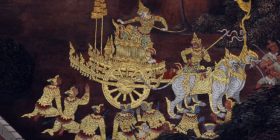There is a great deal of debate about whether there is any historical accuracy in the story of Ramayana. For many of us, this is a no-brainer. The fact that our elders had told us the heroic story of Lord Ram’s victory over Raavan was enough. And then there’s the if-there’s-a-TV-show-about-it-it-must’ve-happened crowd.
But that’s not how history works.
There are many things about the Ramayana that are absolutely mythological. A demon king with ten heads? Yeah, right. Talking monkeys? Nope. Didn’t exist. Demon uncle that could morph into a deer? Don’t think so. A flying chariot? No way. Demi-god who could take the form of a vulture? Again, no. But here’s the thing – Ramayana wasn’t originally written as a historical text but as an epic poem. Whether we like it or not, creative liberty was a thing back then too.
But if we remove all the myth from the story, it is basically about an exiled prince waging war against a king from another kingdom who kidnapped his wife. And that could have happened. We cannot prove or disprove anything. But at least we can present a list of places that are mentioned in the Ramayana.

The place in Ayodhya where Hanuman was patiently waiting while Ram was in exile, is now a temple called Hanuman Garhi

There’s an actual Janki Temple in Janakpur in Nepal. Janki, as we know, is another name for Sita, Janaka’s daughter.

When Ram, Sita and Lakshman went into exile, they set up a hut in Panchavati, which is an actual area near Nashik. Tapovan, a nearby spot, is where Lakshman encountered Surpanakha.

When Sita was abducted by Raavan, they bumped into Jatayu, a demi-god in vulture form, who tried his best to stop Raavan. Lepakshi, in Andhra Pradesh, is said to be the place where Jatayu fell.

Ram, accompanied by Hanuman, met the dying Jatayu. Ram helped him attain moksha by uttering the words “Le Pakshi“, which is Telugu for “Rise, bird”. Hence the name, Lepakshi. There’s also a large footprint in that area which is said to be that of Hanuman’s

Ram Sethu, the bridge made of stones built by Ram’s army that connected the mainland to the island kingdom of Lanka, actually exists, albeit now, it’s underwater.

Meanwhile, in Lanka, Raavan’s devotion to Lord Shiva earned him the respect of the God. So much so that he built his devotee a temple. This is the only time when a temple is dedicated to the one who prayed and not the one being prayed to. Today, it exists as Koneswaram Temple in Sri Lanka.

Here’s the part of the temple where Raavan has been idolized. While having 10 heads is an exaggeration, the idea is based on the fact that Raavan ruled 10 kingdoms which meant that he had 10 different crowns.

It is said that the Kanniya hot wells near the temple were also built by Raavan. They still exist

When Raavan brought Sita to Lanka, he first took her to this place called Sita Kotuwa, which is now a tourist spot in Sri Lanka.

From here, he took her to the beautiful forest, which in Valmiki’s text was called Ashok Vatika. There is an actual Ashokavanam in Sri Lanka.

When Hanuman reached Ashok Vatika, he is said to have come in the form of a giant. There are giant imprints on one side of the lake there which are said to be Hanuman’s footprints, formed when he landed.
When they say “Hanuman set Lanka on fire” what they actually mean is he set fire to certain parts of Raavan’s palace. The ground here is said to be somewhat black which is nothing like the surrounding area. The picture below is from Ussangoda, which according to mythology was the landing strip for Raavan’s Pushpak Vimaan




Leave a reply